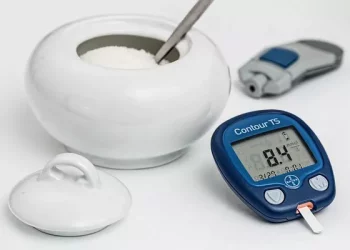How Insulin Resistance Affects the Body
Impaired Glucose Metabolism: The most obvious effect of insulin resistance is on glucose metabolism. Since cells are not properly responding to insulin, they are unable to take up glucose effectively. This leads to elevated blood sugar levels, which can have a domino effect on other body systems. The body may try to compensate by producing even more insulin, but this can only work for a limited time. Eventually, the pancreas may become exhausted and unable to produce sufficient insulin, which can progress to type 2 diabetes.
Fat Storage and Metabolism: Insulin also has a role in fat metabolism. In insulin resistance, the body’s ability to store and use fat is disrupted. Instead of being properly stored in adipose tissue or used for energy, fat may be deposited in abnormal places such as around the liver and in the muscles. This can further contribute to metabolic problems and increase the risk of developing fatty liver disease. For example, in the liver, the accumulation of fat can lead to inflammation and impaired liver function.
Cardiovascular Complications: Insulin resistance is closely linked to an increased risk of cardiovascular disease. High blood sugar levels and abnormal lipid profiles (such as elevated triglycerides and low HDL cholesterol) that often accompany insulin resistance can damage the blood vessels. This damage can lead to the formation of plaque, which narrows the arteries and restricts blood flow. As a result, the risk of heart attacks, strokes, and peripheral vascular disease is significantly increased. For instance, the thickening of the arterial walls due to plaque buildup can reduce the supply of oxygen-rich blood to the heart muscle, potentially leading to a heart attack.
Symptoms of Insulin Resistance
Fatigue: One of the common symptoms of insulin resistance is fatigue. When cells are not getting enough glucose to produce energy, the body feels tired and lethargic. This is because glucose is the primary fuel for cells, and without proper uptake, the cells are operating at a suboptimal level. For example, a person with insulin resistance may feel exhausted even after a full night’s sleep or have difficulty performing daily activities that usually require minimal effort.
Increased Thirst and Frequent Urination: High blood sugar levels caused by insulin resistance can lead to increased thirst and more frequent urination. The kidneys work to filter out the excess glucose from the blood, and this requires more water. As a result, the body becomes dehydrated, triggering the sensation of thirst. A person may find themselves drinking more fluids than usual and having to urinate more frequently, sometimes even waking up multiple times during the night to urinate.
Difficulty Losing Weight: Insulin resistance can make it extremely difficult to lose weight. The body’s metabolism is disrupted, and it may be more inclined to store fat rather than burn it. Even with a reduced-calorie diet and increased exercise, weight loss may be slow or non-existent. This is because insulin resistance affects how the body processes and stores nutrients, and it can be a frustrating obstacle for those trying to manage their weight.
Blurred Vision: Elevated blood sugar levels can affect the eyes. The lenses of the eyes can swell due to the osmotic effect of high glucose levels, leading to blurred vision. If left untreated, this can progress to more serious eye problems such as diabetic retinopathy, which can cause vision loss. A person with insulin resistance may notice that their vision is not as sharp as it used to be, especially when reading or looking at distant objects.
Darkened Skin Patches: Some individuals with insulin resistance may develop darkened, velvety patches of skin. These patches, known as acanthosis nigricans, are often found in areas such as the neck, armpits, and groin. The exact mechanism behind this is not fully understood, but it is thought to be related to the body’s attempt to compensate for the insulin resistance. It may be a visible sign that something is amiss with the body’s metabolic processes.
Diagnosing Insulin Resistance
Fasting Blood Glucose Test
This is a basic test that measures the level of glucose in the blood after an overnight fast. A normal fasting blood glucose level is typically between 70 and 99 mg/dL. In insulin resistance, the fasting blood glucose may be in the higher end of the normal range or slightly elevated above normal. However, a normal fasting blood glucose does not necessarily rule out insulin resistance, as it may only become apparent when the body is challenged with a glucose load.
Oral Glucose Tolerance Test
In this test, the patient drinks a sugary solution, and then blood glucose levels are measured at intervals over the next few hours. In insulin resistance, the blood glucose levels will rise higher than normal and may take longer to return to baseline. This test provides a more comprehensive picture of how the body processes glucose and can help detect early signs of insulin resistance or impaired glucose tolerance.
Insulin Level Measurement
Measuring the level of insulin in the blood can also be informative. In insulin resistance, the pancreas may produce more insulin in an attempt to overcome the cells’ resistance. So, elevated insulin levels, especially in combination with normal or slightly elevated blood glucose, can suggest insulin resistance. However, interpreting insulin levels can be complex, and it is usually done in conjunction with other tests.
HOMA-IR
This is a calculation that uses fasting blood glucose and insulin levels to estimate insulin resistance. A higher HOMA-IR value indicates greater insulin resistance. It is a useful tool for healthcare providers to assess a patient’s degree of insulin resistance and to monitor changes over time. For example, a HOMA-IR value above 2.5 is often considered indicative of insulin resistance.
Conclusion
Insulin resistance is a complex metabolic condition that requires a comprehensive approach to management. By understanding its causes, symptoms, diagnosis, and treatment options, individuals can take control of their health and reduce the risk of developing serious complications. A combination of lifestyle changes, including dietary modifications, regular exercise, stress management, and, in some cases, medical treatment, is key to effectively managing insulin resistance and maintaining overall well-being.



























